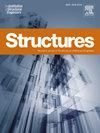反循环荷载作用下RC/PC梁柱节点黏聚区模型集成混合数值模拟策略
IF 4.3
2区 工程技术
Q1 ENGINEERING, CIVIL
引用次数: 0
摘要
梁柱节点是现代钢筋混凝土结构中最普遍的连接形式之一。它们在强震下的抗震性能和断裂行为对结构的安全至关重要,而它们的详细配置的变化导致了力学响应和破坏模式的显著差异。在模拟方法中同时考虑预制混凝土/现浇钢筋混凝土节点的滞回性能和表观断裂行为一直是一个挑战。本研究提出了一种创新的模拟策略,将内聚区模型(CZM)与三维模型(3D)相结合,称为双层模型。三维模型模拟了PC/RC节点的滞回线、变形和能量耗散,而CZM层则在局部水平上捕捉了PC/RC节点的断裂行为。边界被单独捆绑以实现时间序列同步变形。针对混凝土损伤塑性(CDP)模型中压缩刚度恢复系数(wc)确定的模糊性,提出了一种将CDP模型与焦点模型相结合的刚度恢复路径计算方法。在此基础上,基于面积等效原理和多级损伤分区的概念,建立了一种确定wc的标定方法,并引入了与连接参数相关的损伤区间分离点。随后,对3个不同连接刚度和配置的PC/RC梁柱节点进行了验证和对比分析。仿真与实验验证结果表明,几乎所有主干网点误差都在15% %以下。开裂前后的刚度、承载能力趋势和能量耗散均表现出可接受的一致性。所有试件的破坏模式视觉相似性超过60% %。通过对比分析,确认了CZM层和wc组态建模的充分性。本文章由计算机程序翻译,如有差异,请以英文原文为准。
Cohesive zone model-integrated hybrid numerical simulation strategy for RC/PC beam-column joints under reversed cyclic loadings
Beam-column joints represent one of the most prevalent connection types in modern reinforced concrete structures. Their seismic performance and fracture behavior under strong earthquakes critically govern structural safety, while variations in their detailing configurations lead to significant differences in mechanical response and failure modes. Simultaneously accounting for the hysteretic performance and apparent fracture behavior of precast concrete (PC)/cast-in-situ reinforced concrete (RC) joints in simulation methods has always been challenging. This study proposes an innovative simulation strategy by combines cohesive zone model (CZM) with three-dimensional (3D) model, referred to as the dual-layer model. The 3D model simulates the hysteresis loops, deformation, and energy dissipation of PC/RC joints, while CZM layer captures their fracture behavior at local level. The boundaries are individually tied to achieve time-sequence synchronization deformation. To address the ambiguity in determination the compressive stiffness recovery factor (wc) in the concrete damaged plasticity (CDP) model, a calculation method for the stiffness recovery path is developed by integrating the CDP model with the focus points model. Furthermore, based on the principle of area equivalence and the concept of multilevel damage zoning, a calibration method is established to determine wc, and the interval separation point of damage which is related to connection parameters is introduced. Subsequently, verification and comparative analysis are conducted on three PC/RC beam-column joints with varying connection stiffness and configurations. Verification results between simulation and experiment indicate that nearly all backbone points errors below 15 %. Acceptable consistency is demonstrated in stiffness, load-bearing capacity trends, and energy dissipation before and after cracking. The visual similarity of the failure patterns exceeds 60 % across all specimens. The modeling adequacy of the CZM layer and the wc configuration is confirmed through comparative analysis.
求助全文
通过发布文献求助,成功后即可免费获取论文全文。
去求助
来源期刊

Structures
Engineering-Architecture
CiteScore
5.70
自引率
17.10%
发文量
1187
期刊介绍:
Structures aims to publish internationally-leading research across the full breadth of structural engineering. Papers for Structures are particularly welcome in which high-quality research will benefit from wide readership of academics and practitioners such that not only high citation rates but also tangible industrial-related pathways to impact are achieved.
 求助内容:
求助内容: 应助结果提醒方式:
应助结果提醒方式:


